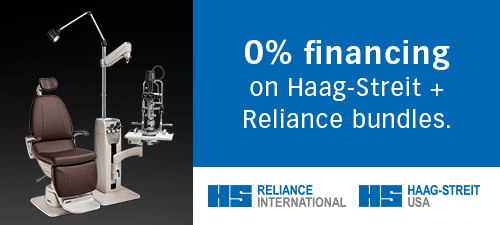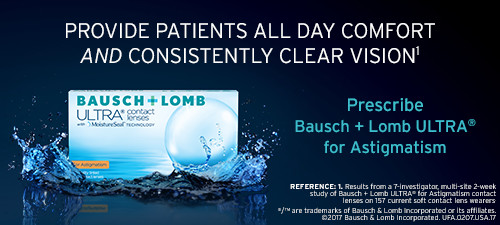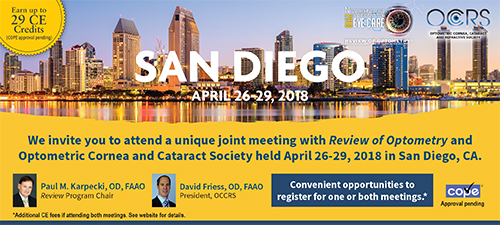
A
weekly e-journal by Art Epstein, OD, FAAO
Off the Cuff: Our Student Problem
Optometry has a student problem. The problem lies at the intersection of greed, opportunity, exploding technology, wishful thinking and outright lies. We all know it, but those invested in continuing to expand the profession beyond reasonable limits prefer that we turn a blind eye and not talk about it. For some schools recent board scores have been concerning. We could rail against the NBEO—and there are good reasons to be critical—but board scores remain a good measure of the quality of students being produced. It’s not the only metric, but one sufficiently important to have changed the way at least one school runs its program. I also suspect that some schools concentrate more on achieving better board results than on clinical skills. If true, that would be profoundly disturbing. Ultimately, the future of optometry will be determined by the rules of supply and demand—a reality that will eventually hit some of the schools and, unfortunately, many of their graduates like an out of control freight train. While economics will always play a role in optometric education, public need rather than greed must always be the primary motivation for starting a new program.Trying to create additional demand for ODs, as ASCO and the AOA are doing, may seem like a sound strategy, but as more schools continue to open while candidate pools continue to shrink, it will be a race to the bottom. If our organizations are unable to stop the down spiral, the only option left may be to take matters into our own hands and actively discourage some OD candidates. While an unprecedented and unpleasant task, it may be the only way to save optometry.
|
|||||

|
||
| Hydrogel Contact Lens Water Content is Dependent on Tearfilm pH | ||||
Based on clinical inferences, investigators theorized in situ soft lens hydration was linked to the precorneal tearfilm pH. Forty-one myopic subjects in Fort Rucker, Ala., were fitted with one of two types of extended-wear soft contact lenses, and were followed quarterly for a period of 33 months. The anterior soft contact lens surface pH was measured in situ, while the in vitro lens water content was measured immediately after lens removal, using a handheld refractometer on one lens and a gravimetric means of hydration measurement on the other lens. The in situ pH increased logarithmically across extended wearing time, reaching an asymptote at approximately five days’ wearing time at a pH of 7.45 ± 0.03. Lens water content was shown to similarly decrease at an inversely logarithmic rate, leveling off at four to five days’ extended wearing time. Both means of hydration assessment correlated well with each other across days' extended wearing time. A log-log dual conversion yielded significantly different linear slopes, based on a multifactorial analysis of both lens types, by pH and water content. The differing ionic status of each material accentuated their varied polar attraction characteristics. Two soft lenses, identical in all patient-based parameters, could provide differing oxygen availability, as well as differing physical fits in patients of identical physical characteristics, as a result of their unique tearfilm pH differences. The in situ hydrogel lens water content is directly dependent on the precorneal tearfilm pH. |
||||
SOURCE: Lattimore MR, Harding TH, Williams ST. Hydrogel Contact lens water content is dependent on tearfilm pH. Mil Med. 2018;183(suppl_1):224-30. |
||||
|
||||
| Comparison of Central Corneal Thickness Measured by Standard Ultrasound Pachymetry, Corneal Topography, Tono-Pachymetry and Anterior Segment Optical Coherence Tomography | ||||
A cross-sectional study of central corneal thickness (CCT) measurement in 52 eyes of 52 healthy volunteers was conducted by a single examiner at the Ocular Surface and Contact Lens Laboratory to compare CCT measured by standard ultrasound pachymetry (USP) and three non-contact devices in healthy eyes. Three consecutive measurements were performed by standard USP, a non-contact tono-pachymeter, Pentacam corneal topographer,and Anterior Segment Optical Coherence Tomography (AS-OCT). The mean values were used for assessment. The results were compared using multivariate ANOVA, linear regression and Pearson’s correlation. Agreement among the devices was analyzed using mean differences and Bland-Altman analysis with 95% limits of agreement (LoA). Finally, reliability was analyzed using the intraclass correlation coefficient (ICC).
Mean CCT by ultrasound pachymeter, tono-pachymeter, corneal topographer and AS-OCT were 558.9µm ± 31.2µm, 525.8µm ± 43.1µm, 550.4µm ± 30.5µm and 545.9µm ± 30.5µm respectively. There was a significant positive correlation between AS-OCT and USP, corneal topography and USP, and corneal topography and AS-OCT. There was a lower correlation between CT-1P tono-pachymeter and the other three modalities. Intraclass correlation coefficients showed an excellent reliability between pairs except for CT-1P against the other three instruments that were found to be moderate. Researchers wrote that CT-1P tono-pachymeter underestimated CCT measurements compared with the Scheimpflug system, AS-OCT and USP. They found that mean CCT among USP, Pentacam and AS-OCT were comparable and had significant linear correlations. Researchers concluded that, in clinical practice, these three modalities could be interchangeably used in healthy patients. |
||||
SOURCE: González-Pérez J, Queiruga Piñeiro J, Sánchez García Á, et al. Comparison of central corneal thickness measured by standard ultrasound pachymetry, corneal topography, tono-pachymetry and anterior segment optical coherence tomography. Curr Eye Res. 2018; Apr 10. [Epub ahead of print]. |
||||

|
||
| Contact Lens Correction of Aphakia in Children: A Report by the American Academy of Ophthalmology | ||||
Literature searches were conducted in January 2018 in PubMed, Cochrane Library and ClinicalTrials.gov databases, with no date or language restrictions, to review the published literature of visual outcomes and adverse events associated with the two most commonly used contact lenses for treating aphakia in children: silicone elastomer (SE) and rigid gas permeable (RGP). These combined searches yielded 167 citations, 27 of which were reviewed in full text. Of these, 10 articles were deemed appropriate for inclusion in the investigators’ assessment and were subsequently assigned a level of evidence rating by the panel methodologist.
The literature search identified four level II studies and six level III studies. There were insufficient data to compare visual outcomes for eyes treated using SE lenses vs. RGP lenses. Silicone elastomer lenses had the advantage of being worn on an extended-wear basis, but they were associated with more adverse events than RGP lenses. These adverse events included microbial keratitis, corneal infiltrates, corneal edema, corneal scars, lenses adhering to the cornea, superficial punctate keratopathy, lid swelling and conjunctival hyperemia. The lens replacement rate was approximately 50% higher for RGP lenses in the only study that directly compared SE and RGP lenses. Limited evidence was found in the literature on this topic. The authors determined that silicone elastomer and RGP contact lenses were effective for treating aphakia in children. They found silicone elastomer lenses to be easier to fit and able to be worn on an extended-wear basis. Rigid gas permeable lenses needed to be removed every night and required a more customized fit, but were associated with fewer adverse events. The authors suggested that the choice of which lens a practitioner prescribes should be based on the particular needs of each patient. |
||||
SOURCE: Lambert SR, Kraker RT, Pineles SL, et al. Contact lens correction of aphakia in children: A report by the american academy of ophthalmology. Ophthalmology. 2018; Apr 6. [Epub ahead of print]. |
||||
| News & Notes | |||||||||||||||
| J&J Vision Announces Contact Lens Innovation: Acuvue Oasys with Transitions Light Intelligent Technology Johnson & Johnson Vision unveiled Acuvue Oasys with Transitions Light Intelligent Technology, a first-of-its-kind contact lens that provides wearers with vision correction and a dynamic photochromic filter that helps to continuously balance the amount of light entering the eye. The contact lenses quickly and seamlessly adjust from clear to dark in response to changing light conditions, reducing exposure to bright light indoors and outdoors, including filtering blue light and blocking UV rays. The lenses automatically adapt, helping the human eye manage different types of light and varying intensities of brightness throughout the day. The strategic partnership between Johnson & Johnson Vision and Transitions Optical combines the respective strengths of each company. Acuvue Oasys With Transitions has received FDA 510(k) clearance and is indicated for the attenuation of bright light. The two-week reusable, spherical contact lens will be marketed by Johnson & Johnson Vision Care and commercially available in first half of 2019. Read more. |
|||||||||||||||
| MACUSTAR Study to Validate Endpoints for AMD Trials MacuLogix announced that AdaptDx—which provides an objective way to measure dark adaptation with a test that can be completed in a few minutes—was selected as a functional testing device for candidate clinical endpoint development in the MACUSTAR project, a five-year study exploring novel outcome measures for future interventional trials in individuals with intermediate AMD. The device works by measuring a patient’s Rod Intercept time—the number of minutes it takes for the eye to adapt from bright light to darkness. Read more. |
|||||||||||||||
| B+L to Showcase Innovations, Scientific Data During ASCRS Annual Meeting Bausch + Lomb will highlight its latest innovations, including the enVista MX60E intraocular lens with StableFlex technology, and new scientific data during the American Society of Cataract and Refractive Surgery Annual Meeting, April 13-17, in Washington, D.C. A wet lab at the company’s booth (#2242) and educational programs will provide opportunities for individuals to learn more about, and gain first-hand experience with, Bausch + Lomb technologies. The technologies featured will include the company’s latest next-generation platform for cataract and retina surgery: Stellaris Elite, the Victus femtosecond laser for advanced cataract and corneal applications, and its wide selection of IOLs and delivery systems, including the new enVista MX60E with StableFlex technology, as well as the Crystalens AO and Trulign Toric. Schedule an appointment in the wet lab visit: www.testdrivebausch.com Read more. |
|||||||||||||||
| Avedro Names Schuermann Chief Business Officer Avedro announced that James F. Schuermann joined the company as chief business officer. Schuermann will oversee the expanded commercialization of Avedro’s cross-linking drugs and devices. He brings more than 20 years of global medical device experience and joins from Medtronic, where he served as vice president and general manager of mechanical circulatory support, a $300 million business unit comprised of legacy HeartWare and related ventricular assist device systems. Read more. |
|||||||||||||||
| Allergan Launches TrueTear Intranasal Neurostimulation Device During ASCRS/ASOA Annual Meeting Allergan announced the official launch of TrueTear, the first and only FDA-cleared device developed to temporarily increase tear production during neurostimulation in adult patients, during the 2018 American Society of Cataract and Refractive Surgery and American Society of Ophthalmic Administrators annual meetings being held April 13 to 17 in Washington, D.C. The handheld neurostimulation device with disposable tips is inserted into the nasal cavity to induce the production of natural tears. In two clinical trials, the device was shown to be safe and effective for temporarily increasing tear production in adult patients. Read more. |
|||||||||||||||
| Alcon Helps ECPs Encourage Patients to “Lose Their Readers” During Presbyopia Awareness Month During April’s Presbyopia Awareness Month, Alcon is offering a unique opportunity for ECPs to help their presbyopic patients lose their readers or avoid the inconvenience of wearing reading glasses in the first place. The company is increasing multifocal resources and training opportunities to support contact lens fitting efficiency and presbyopic patient satisfaction. It has more than doubled its hands-on multifocal contact lens trainings in its in-house, state-of-the-art Alcon Experience Center. The company is also increasing offerings of its proprietary Multifocal Fit Training Road Shows, taking the trainings directly to practitioners’ offices. Read more. |
|||||||||||||||
| FDA Permits Marketing of AI-Based IDx-DR The U.S. Food and Drug Administration authorized marketing of the first medical device to use artificial intelligence to detect greater than a mild level of the eye disease diabetic retinopathy in adults with diabetes. The device, called IDx-DR, is a software program using an artificial intelligence algorithm to analyze ocular images taken with the Topcon NW400 retinal camera. IDx-DR is the first device authorized for marketing that provides a screening decision without the need for a clinician to also interpret the images or results. Read more. |
|||||||||||||||
| Dallas Lighthouse for The Blind to Merge With Envision After Envision merges with Dallas Lighthouse for the Blind, operations will continue in Dallas, and the Dallas Lighthouse for the Blind name will be retained. The merger will help individuals with vision loss in Texas and Kansas who are seeking meaningful employment opportunities in high-tech and emerging fields. Read more. |
|||||||||||||||
|
|||||||||||||||
|
Optometric Physician™ (OP) newsletter is owned and published by Dr. Arthur Epstein. It is distributed by the Review Group, a Division of Jobson Medical Information LLC (JMI), 11 Campus Boulevard, Newtown Square, PA 19073. HOW TO ADVERTISE |




